Site report: Seattle wastewater tunnel project on track
28 February 2022
Seattle is midway through a US$570m wastewater tunnelling project involving the creation of a 2.7 mile long underground storage tunnel using a 6.6m diameter TBM. Lucy Barnard reports.
Deep beneath the streets of Seattle in the northwest USA, a giant tunnel boring machine (TBM) is slowly borrowing its way along a 2.7-mile route in the city’s latest attempt to reduce the amount of pollution spilling out into the waters around it.
Christened ‘MudHoney’ after a popular vote in honour of the Seattle-based grunge band, the custom-designed Earth Pressure Balance (EPB) Pressurised Face TBM from German manufacturer Herrenknecht, rolled off factory lines in 2020 and started tunnelling work in September 2021.
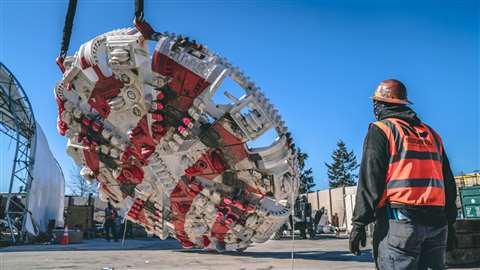 MudHoney’s cutterhead is lowered into position in the Ballard shaft in April 2021. Photo: Lane Construction
MudHoney’s cutterhead is lowered into position in the Ballard shaft in April 2021. Photo: Lane Construction
As of mid-February 2022, MudHoney had travelled 936 feet of its 13,946 feet journey to the district of Wallingford on the north shore of Lake Union from a starting point at Ballard at the edge of the ocean, inching forward at an average rate of around 50 feet per day. The machine is expected to reach Wallingford by the end of 2022.
And as MudHoney crawls its way underground towards its destination, the city authorities which own it, will be hoping that this latest TBM project can finally turn the page on Seattle’s last major single bore tunnel under the city centre which ended up with a two-year construction delay and an ongoing lawsuit.
Back in 2013, a 57.5-foot (17.5m) diameter TBM, named Bertha, built specifically for Washington State Department of Transport’s Alaskan Way Viaduct replacement tunnel, and made by Hitachi Zosen in Osaka, Japan - at the time billed as the largest TBM ever built - was halted just 1,083 feet (330m) into a planned 9,270 foot (2,830m) long route because of an unexpected impediment. Crews were forced to dig a recovery pit from the surface to repair and replace parts of its cutterhead in 2015, with costly overruns.
Set of infrastructure upgrades
Seattle Public Utilities and King County, the two local authorities undertaking Seattle’s latest major infrastructure project are quick to distance themselves from the Bertha project and point out that both tunnelling and construction work for their unrelated project are currently on budget and on time.
The Seattle Ship Canal Water Quality Project comprises a set of infrastructure upgrades, the largest of which involves drilling the 18.1 feet diameter tunnel under the north side of the Lake Washington Ship Canal. (See map below.)
When complete, the tunnel will be able to temporarily store more than 29.6 million gallons of untreated stormwater and sewage which would normally have overflowed into the city’s Ship Canal, until Seattle’s treatment plants are ready for it.
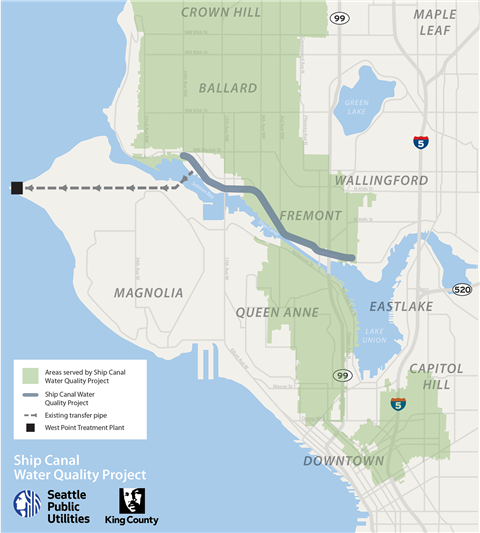 The storge tunnel location. Image: SPU
The storge tunnel location. Image: SPU
Keith Ward, Ship Canal water quality program executive at Seattle Public Utilities, says that the city is using a variety of methods of dealing with its overflowing wastewater but, his team felt early on that constructing a tunnel to store wastewater was an important part of the solution.
Storage tunnel reduces overflows from sewers
“Ultimately building a tunnel is much less impactful to the community both during construction and afterwards during operations,” says Ward.
The plan, which is being undertaken by main contractor Lane Construction, the US arm of Italian contractor Webuild Group, involves digging five vertical shafts in the neighbourhoods of Ballard, East Ballard, Freemont, Queen Anne and Wallingford which, during heavy rain, will collect storm water and sewage flows from each flood basin and send them 40-80 feet (12-24m) under the ground to the tunnel until the city’s sewage plant in Magnolia can cope with it.
Wastewater from the Queen Anne district on the south side of the city will be piped through an extra 8-foot diameter tunnel running underneath the Ship Canal.
“The storage tunnel location was identified based on several criteria, including minimizing impacts to surrounding neighbourhoods, transit corridors, utilities, and structures such as businesses and homes,” Ward adds.
Widening the tunnel
To work out how wide to make the tunnel, SPU and its advisors initially looked back at the city records to see how much rainfall Seattle experienced each year which led them to calculate that they needed a 14-foot (4.3m) diameter tunnel. However, while Seattle was crunching the numbers, Rain City got even wetter. Rainfall in 2014, 2015, 2016 and 2017 set a new record for the wettest four-year period in the city’s history, with at least 44 inches falling each year during the period. Looking at their hydrologic/hydraulic models, the engineers realised they were going to need a bigger tunnel.
“The tunnel diameter was increased in 2017 to account for two factors. First, recent rainfall patterns were different than earlier historical data. Second, anticipated future climatic changes required additional storage volume for the facility to remain in regulatory compliance,” says Ward. “Neither of these factors were incorporated in the original tunnel sizing.”
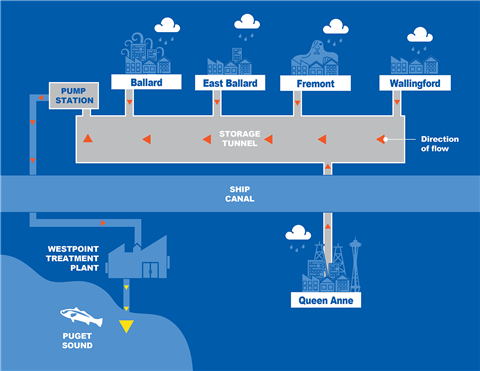 How the tunnel will work. Image: SPU
How the tunnel will work. Image: SPU
By increasing the tunnel diameter by just over a meter to 18ft 10in (5.7m), Ward says that the amount of water it could hold nearly doubled from about 16 million to 30 million-gallons (60.5 million to 113.5 million-litres) while the project’s costs only increased by 5%, so far keeping the overall project within its $570 million budget.
“Changing the size of the storage tunnel created some minor engineering and design changes,” Ward says.
“These included modifications to tunnel openings for the TBM launch and reception shafts and tunnel air flow; a validation of the tunnel muck disposal option due to increased volumes; and slightly larger easements along small portions of the tunnel alignment that are not in public right of way.”
Ward says that the team has planned MudHoney’s underground route to mostly follow public streets. However, he points out that driving a nearly 15,000 foot long drill underneath the city has its technical challenges. “Although we tried to mostly stay within public streets, MudHoney has a limited turning radius,” he says. “The turn radius is based on how tight of a corner it can take without getting stuck.”
Like other EPB (Earth Pressure Balance) machines, MudHoney is designed to use excavated material to support the tunnel face while it is being bored. The 14,256 feet (4,345) long machine is operated a crew of 10-15 people in a control room at the front of the machine. In total it weighs more than 865 tonnes.
MudHoney’s cutterhead
Up front, the TBM’s cutterhead has 18 double disc cutters for digging through hard soil and boulders, 48 scrapers to loosen material such as sand and gravel, and 16 bucket cutters around the outside to keep the edge of the tunnel clean.
Further back, 18,000 concrete tunnel segments, manufactured by Washington state-based construction company CSI in Puyallup, WA, are sucked up and swung into place by hydraulic arms behind the cutter head. The concrete segments fit together to form a tunnel ring which will eventually form the wall of the tunnel. As MudHoney advances, it uses the rings it builds as traction to keep moving forward.
MudHoney was shipped to the city in pieces, arriving in March 2021 where it had to be lowered into its starting position, a 107 ft (32.6m) deep 80 foot (24.4m) wide shaft by a 43-foot-tall gantry crane (supplied by Mammoet), still in five separate pieces and then reassembled in situ.
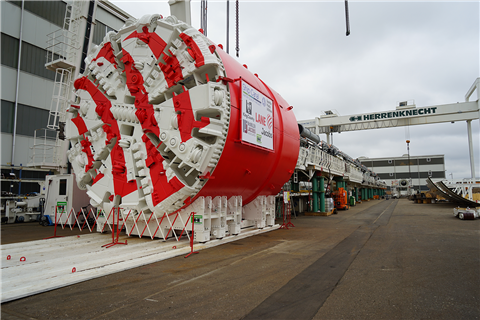 TBM MudHoney. Photo: Webuild Group
TBM MudHoney. Photo: Webuild Group
Tunnelling work started in September 2021 as MudHoney made its way from Ballard towards the next neighbourhood of Freemont with excavated soil moved out of the tunnel to a muck pit at the bottom of the shaft via a temporary conveyor belt.
After digging the first 800 feet, the machine reached a planned pause in October 2021 while engineers swapped the conveyor belt for a rail system and installed more trailing gear. This means that spoils can be removed more quickly, dumped into cars running along a narrow railroad track through the completed tunnel back to Ballard where they are then removed by gantry crane, placed in a storage area to the west of the shaft and trucked off site.
MudHoney began tunnelling again at the end of January this year. The machine’s journey is tracked underground by survey points linked to satellite maps, and crews inside the machine measure the amount of soil that is excavated to make sure the TBM is moving at the expected rate.
And MudHoney is not the only TBM being used in the project. A slurry pressurised face TBM with a diameter of 9 foot 10 inches is currently also burrowing its way under the city, digging the 8-foot diameter concrete reinforced pipe conveyance under the Seattle Ship Canal from Freemont to Queen Anne and is expected to arrive at its destination by the end of 2022.
A second TBM working on the project
The machine is one that was already owned by King County, the joint commissioner of the project, and has been refurbished after completing its Freemont Siphon project in 2017. Manufactured by Herrenknecht in Germany in 2014, the TBM is 646 feet long and is operated remotely by crews of 6-10 people above the ground. Its cutterhead tools comprise 12 double disc cutters, 16 scrapers and 14 chisels. A third conveyance tunnel, running from Ballard to Magnolia, is still being designed. The entire project is expected to be completed in 2025.
Work on the five vertical shafts down which the storm water will flow started in 2020, with teams from foundation contractor Malcolm Drilling using a hydromill to excavate trenches which were then filled with bentonite slurry in order to construct slurry walls of concrete and rebar, before the main shafts themselves were then excavated.
Teams also began jet grouting the soil, using high pressure equipment to inject the ground with stabilising fluid which hardens to form cemented columns under the ground so that tunnelling equipment can be used without destabilising the nearby areas.
Yet, as Seattle Ship Canal Water Quality Project TBMs continue their tunnelling work, a completely different impediment threatens to slow construction – the city’s concrete strike.
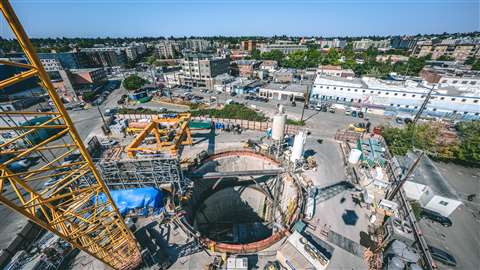 The Ballard shaft in Seattle in July 2021. Source: Lane Construction
The Ballard shaft in Seattle in July 2021. Source: Lane Construction
Currently much of Seattle’s $23bn construction industry has been hit by the strike in which around 330 concrete mixer drivers and plant workers are protesting over pay and conditions, forcing many construction projects to suspend or reduce operations due to a lack of concrete.
“Work [at the Wallingford site] may be suspended by mid-February if the concrete strike has not been resolved,” the construction team says in its latest bulletin, adding that the strike has already prevented pile drilling work to go ahead as planned at its Freemont site.
Since the 1800s, 150 tunnels spanning over 70 miles have been dug under Seattle for sewers, utility corridors and transport. Like many cities around the world with aging pre-war infrastructure, much of Seattle’s rainwater runs into a combined sewer system which transports drainage runoff as well as sewage to regional wastewater treatment plants.
During heavy rain, to prevent flooding in the city centre, the overwhelmed combined sewer system sends untreated wastewater with a mixture of sewage and stormwater into the city’s Ship Canal which flows through the isthmus city in three sections connecting Seattle’s creeks and lakes.
In 2015, the US Environmental Protection Agency and the Department of Ecology filed a lawsuit against the City of Seattle and the neighbouring local authority King County for violating water quality permits, prompting Seattle Public Utilities and King County Wastewater Treatment Division to come up with the plan to prevent the same thing happening again.
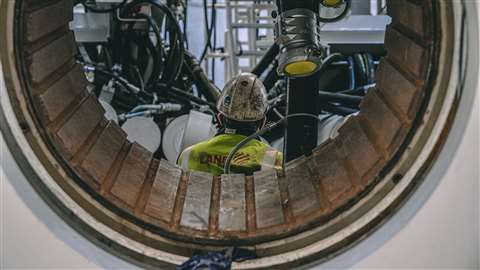 Inside MudHoney. Source: Lane Construction
Inside MudHoney. Source: Lane Construction
“Many agencies across the United States with combined sewers (where stormwater and wastewater are combined in one pipe) must find ways to reduce combined sewer overflows and meet the requirements of the Clean Water Act,” Ward says. “In some cases, the overflow volumes are too large for these other solutions so agencies must use other mitigation measures such as storing the overflow volumes in tanks or tunnels. Many times, the storage tank must be in an urban area that is already developed so acquiring property can be costly and disruptive to residents and businesses. Using a tunnel for storage often reduces the impact to residents and businesses as well as provides flexibility for system operations.”
STAY CONNECTED



Receive the information you need when you need it through our world-leading magazines, newsletters and daily briefings.
CONNECT WITH THE TEAM













